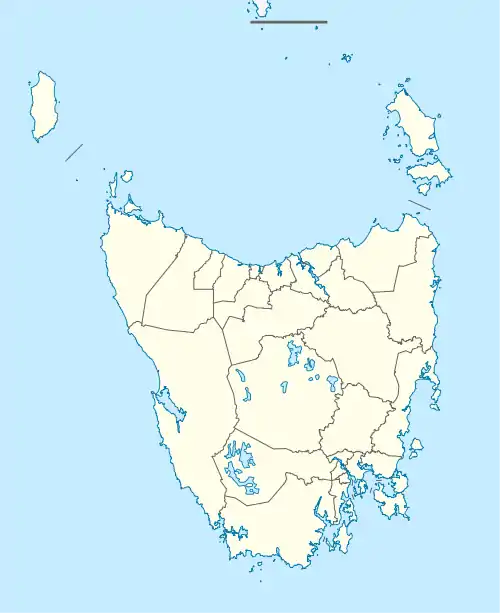| Plenty Tasmania | |||||||||||||||
|---|---|---|---|---|---|---|---|---|---|---|---|---|---|---|---|
 Plenty | |||||||||||||||
| Coordinates | 42°44′26″S 146°57′09″E / 42.74056°S 146.95250°E | ||||||||||||||
| Population | 93 (2016 census)[1] | ||||||||||||||
| Postcode(s) | 7140 | ||||||||||||||
| Location | 9 km (6 mi) NW of New Norfolk | ||||||||||||||
| LGA(s) | Derwent Valley Council | ||||||||||||||
| Region | South-east | ||||||||||||||
| State electorate(s) | Lyons | ||||||||||||||
| Federal division(s) | Lyons | ||||||||||||||
| |||||||||||||||
Plenty is a rural locality in the local government area (LGA) of Derwent Valley in the South-east LGA region of Tasmania. The locality is about 9 kilometres (5.6 mi) north-west of the town of New Norfolk. The 2016 census recorded a population of 93 for the state suburb of Plenty.[1] It is a small locality and the name of a tributary river on the south side of the River Derwent in the Derwent Valley.
Formerly the location of hop growing, and fishing for salmon trout (brown trout), it is now notable for the Salmon Ponds (the original 1864 Plenty river fish hatchery) and the Tasmanian Museum of Trout Fishing.[2]
History
Plenty was gazetted as a locality in 1959.[3] River Plenty Post Office opened on 27 March 1869, was renamed Plenty in 1895 and closed in 1956.[4] The town is notable as it was the location of the first introductions of brown trout outside their native range when in 1864, 300 of 1500 brown trout eggs from the River Itchen survived a four-month voyage from Falmouth, Cornwall to Melbourne on the sailing ship Norfolk. By 1866, 171 young brown trout were surviving in a Plenty river hatchery. Thirty-eight young trout were released in the river in 1866. By 1868, the Plenty River hosted a self-sustaining population of brown trout which became a brood source for continued introduction of brown trout into Australian and New Zealand rivers.[5]
Atlantic salmon, although successfully reared in the Plenty river hatchery and introduced at the same time under the sponsorship of the Acclimatization Society of Victoria, failed to establish themselves in Tasmania or Australia.[6]
2020 river contamination
In 2020, hazardous substances from local composting business Jenkins Hire were allegedly dumped into the nearby Plenty River, resulting in the death of over 100,000 fish. The company produces compost by mixing waste discarded from the pulp and paper mill Norske Skog Boyer, the salmon farming industry, and treated sewage sludge from TasWater. Improper accumulation of waste without adequate drying can produce noxious leachate, contaminating surrounding soils. The company was consequently charged with intentional or reckless environmental pollution and improper storage of controlled waste with a foreseeable risk of environmental escape.[7]
Geography
The River Derwent forms the north-western and northern boundaries. The Plenty River forms a small part of the southern boundary before flowing through to the north.[8]
Road infrastructure
Route B62 (Glenora Road) runs through from north-east to west.[3][9]
Notes and references
- 1 2 "2016 Census Quick Stats Plenty (Tas.)". quickstats.censusdata.abs.gov.au. Australian Bureau of Statistics. 23 October 2017. Retrieved 2 April 2021.
- ↑ "Salmon Ponds: Plenty River, Plenty Fun!". think-tasmania.com. Retrieved 21 February 2014.
- 1 2 "Placenames Tasmania – Plenty". Placenames Tasmania. Select “Search”, enter "1187Y", click “Search”, select row, map is displayed, click “Details”. Retrieved 2 April 2021.
- ↑ Phoenix Auctions History. "Post Office List". Phoenix Auctions. Retrieved 12 February 2021.
- ↑ Heacox, Cecil E. (1974). "Back Cast". The Complete Brown Trout. New York: Winchester Press. pp. 7–23. ISBN 0-87691-129-7.
- ↑ Newton, Chris (2013). "The Strange Case of the Disappearing Salmon". The Trout's Tale - The Fish That Conquered an Empire. Ellesmere, Shropshire: Medlar Press. pp. 57–66. ISBN 978-1-907110-44-3.
- ↑ Bowden, Luke; Murray, Will (15 June 2023). "Rural landowners pay the price as Tasmania struggles with industrial waste". Australian Broadcasting Corporation. Retrieved 24 July 2023.
- ↑ Google (2 April 2021). "Plenty, Tasmania" (Map). Google Maps. Google. Retrieved 2 April 2021.
- ↑ "Tasmanian Road Route Codes" (PDF). Department of Primary Industries, Parks, Water & Environment. May 2017. Archived from the original (PDF) on 1 August 2017. Retrieved 2 April 2021.
- Dimmick, Leonard W. (2004) Fishes and men: the Jones family of Plenty, Tasmania Glenorchy, Tas. L.W. Dimmick. ISBN 0-9578153-2-8